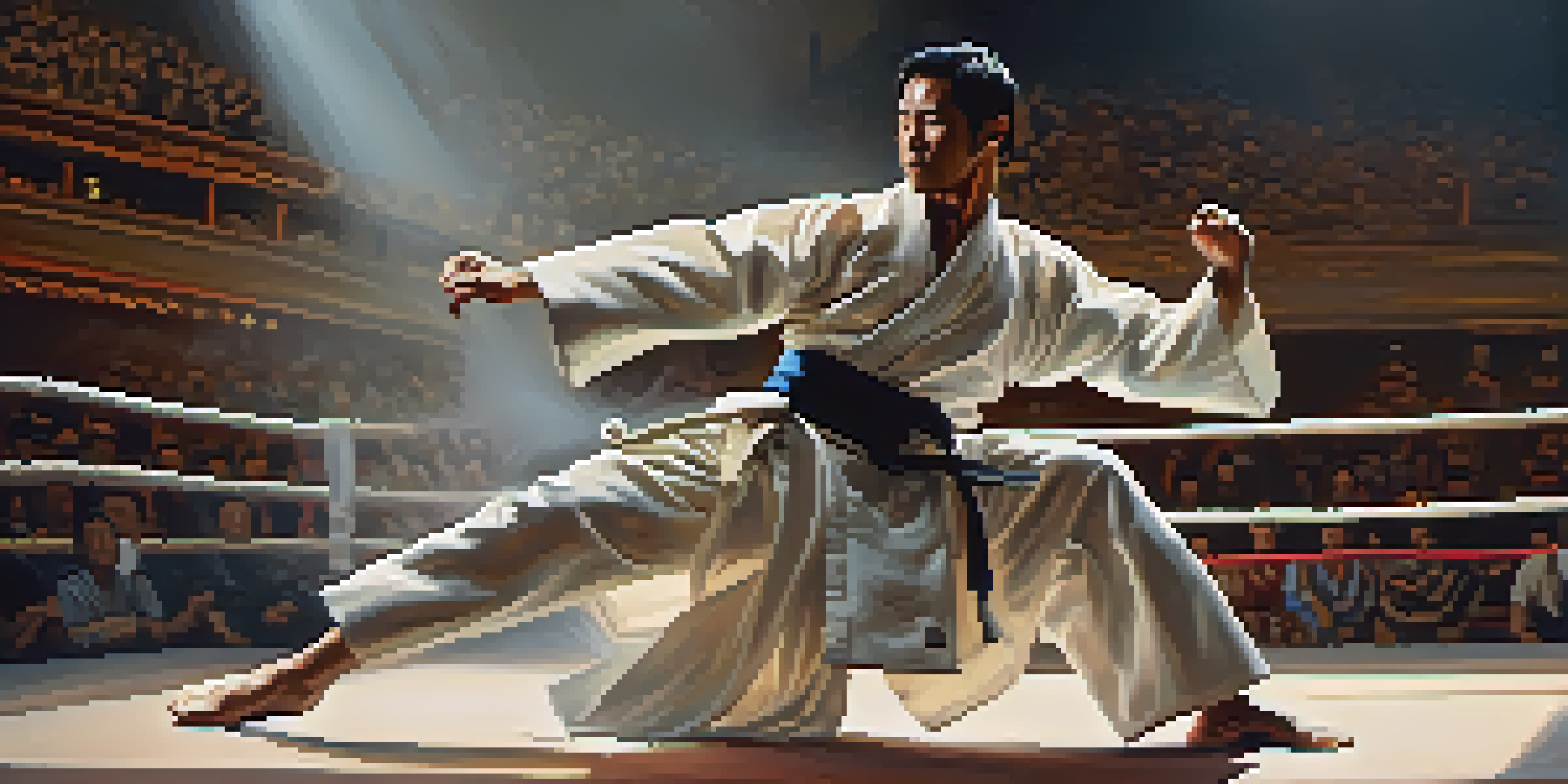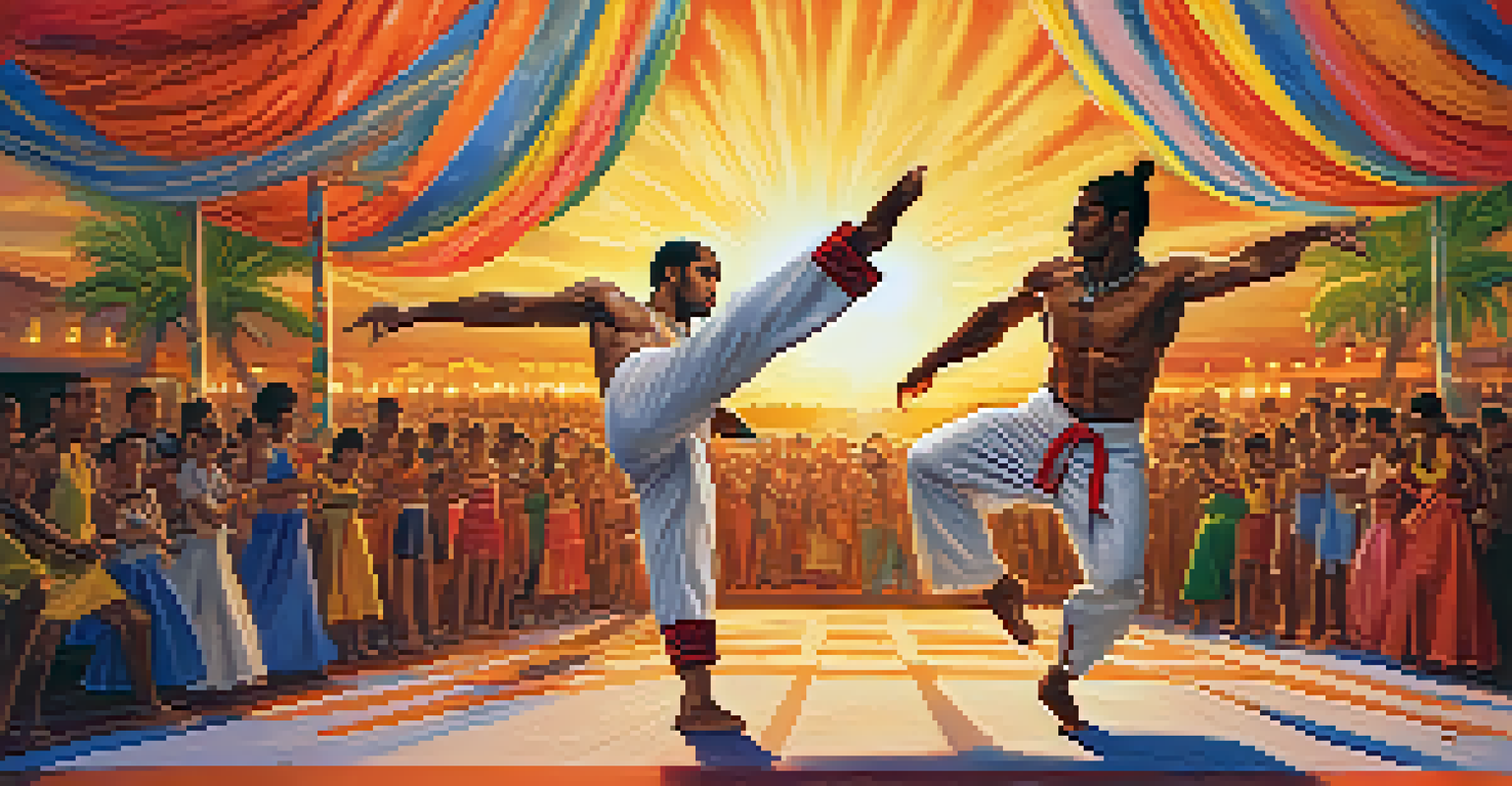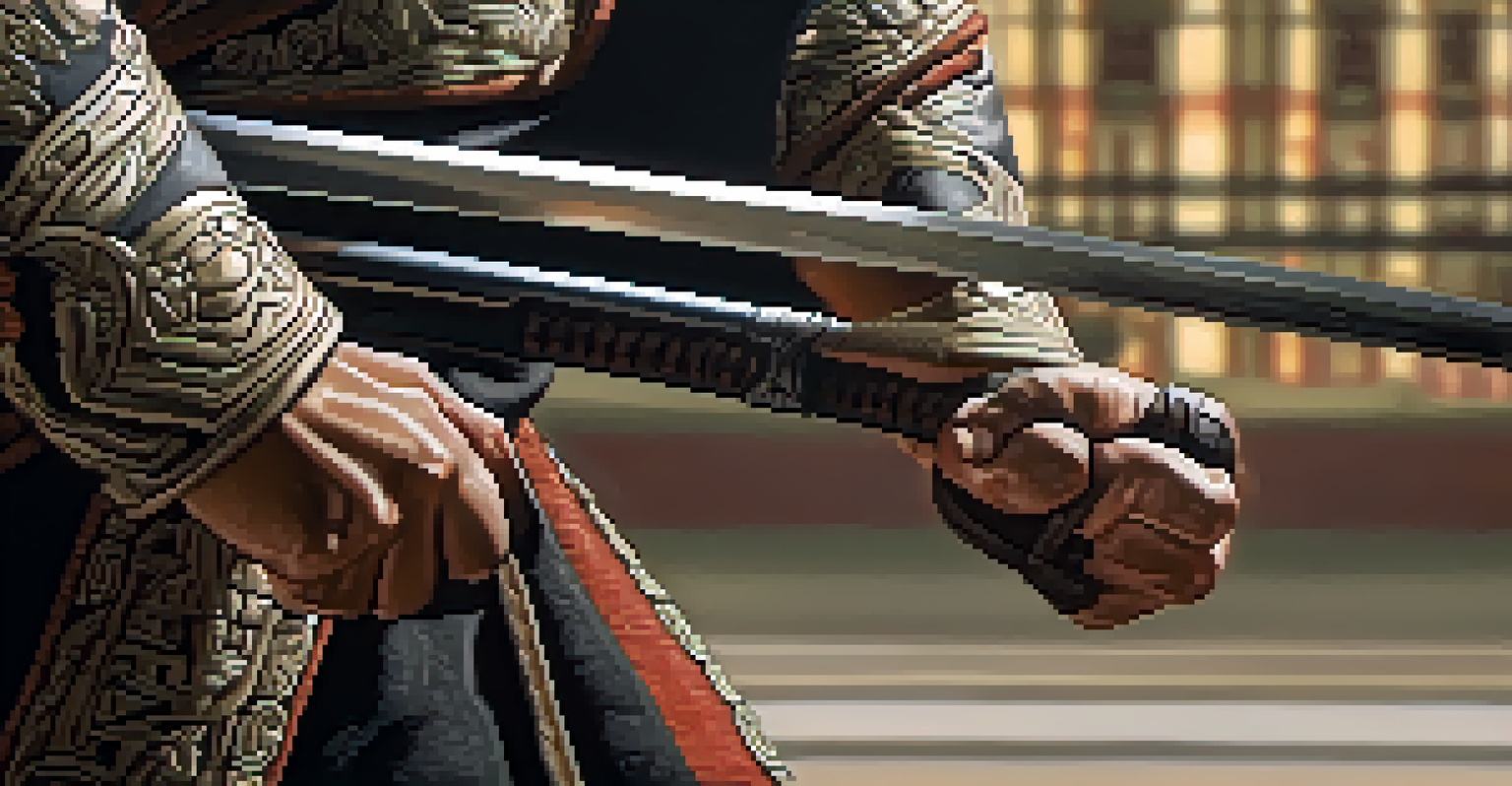Martial Arts as a Form of Expression in Performance Arts

Understanding the Intersection of Martial Arts and Performance Arts
Martial arts, traditionally seen as combat practices, are increasingly recognized for their artistic elements. They combine physical prowess with expressive movements, making them a unique form of performance. This intersection allows practitioners to convey emotions and stories through their techniques, similar to how dancers express feelings through movement.
Martial arts are not just about fighting; they are about finding a deeper connection with oneself and expressing that through movement.
In performances, martial artists utilize their skills to not only entertain but also to communicate deeper messages. For instance, a choreographed fight scene can reflect themes of conflict, resolution, or personal struggle. Just like in theater, the martial artist takes on a role, engaging the audience in a narrative that goes beyond mere physicality.
The blend of martial arts and performance art challenges our perception of both fields. It expands the definition of what art can be, showing that not all expressions of creativity are confined to traditional mediums like painting or dance. This fusion creates a dynamic platform for storytelling and self-expression, captivating audiences worldwide.
Historical Roots of Martial Arts in Performance
Martial arts have a rich history tied to cultural performances across the globe. In many Asian cultures, martial arts were often included in theatrical performances, showcasing not just fighting skills but also storytelling through movement. These performances, such as Chinese opera or Japanese Noh theater, highlight the artistry involved in martial practices.

Notably, forms like Capoeira from Brazil combine dance, acrobatics, and music, making them a vibrant cultural performance. This historical context reveals how martial arts have long been intertwined with artistic expression, allowing them to evolve into performance art. The rhythmic movements and choreographed sequences are a testament to the artistry in martial training.
Martial Arts as Performance Art
Martial arts blend athleticism and artistry, allowing practitioners to tell stories and convey emotions through movement.
Understanding these historical roots enriches our appreciation of martial arts as performance. It shows that these practices are not merely about combat but are deeply embedded in cultural narratives. As such, they serve as a bridge between history and contemporary art forms, inviting new interpretations and creative expressions.
Martial Arts in Modern Performance Art
Today, martial arts have found a significant place in modern performance art. Artists and choreographers are increasingly incorporating martial techniques into their work to create compelling narratives. This blend of disciplines brings a fresh perspective, engaging audiences who appreciate both the athleticism and artistic expression.
Art is the most beautiful of all lies; it is a form of magic that allows us to convey our emotions and stories in ways that transcend language.
One prominent example is the use of martial arts in contemporary dance performances. Dancers may integrate martial techniques to enhance their movements, adding an element of strength and precision. This fusion not only elevates the choreography but also offers a unique visual experience that captivates viewers.
Moreover, performances such as those seen in Cirque du Soleil or theatrical adaptations of martial arts films highlight this synthesis. They showcase how martial arts can enhance storytelling, making it more dynamic and engaging. This modern approach has opened new avenues for performers, allowing them to explore the boundaries of both art forms.
The Role of Emotion in Martial Arts Performance
Emotion plays a crucial role in both martial arts and performance arts, shaping how stories are conveyed. Practitioners often draw on their feelings to enhance their performance, whether it's showcasing a fierce battle or a moment of vulnerability. This emotional connection helps to create a more immersive experience for the audience.
For instance, a martial artist portraying a character in a performance might express anger through powerful strikes or sadness through fluid movements. Each technique can carry emotional weight, transforming a simple display of skills into a poignant narrative. This ability to channel emotions is what sets martial arts performances apart from mere demonstrations.
Cultural Heritage in Performances
Martial arts performances celebrate cultural traditions and heritage, fostering community pride and cross-cultural understanding.
By harnessing emotion, martial artists can resonate with their audience on a deeper level. It invites viewers to connect with the performance, evoking empathy and understanding. This emotional engagement is essential for creating impactful performances that leave a lasting impression.
The Aesthetic Elements of Martial Arts in Performance
Aesthetics play a significant role in how martial arts are perceived as a performance art. The visual appeal of movements, costumes, and stage design all contribute to the overall experience. Martial arts often emphasize form, fluidity, and rhythm, creating a captivating spectacle that draws in audiences.
Choreographers frequently focus on the beauty of martial techniques, highlighting their grace and precision. This attention to aesthetics can transform a fight scene into a dance-like performance, blurring the lines between combat and art. The result is a harmonious blend that captivates viewers and showcases the elegance of martial arts.
Additionally, the use of music and lighting enhances the aesthetic experience, setting the mood for the performance. A well-timed soundtrack can elevate the intensity or serenity of a scene, guiding the audience's emotional journey. This consideration of aesthetics not only enriches the performance but also reinforces the idea that martial arts can be a legitimate form of art.
Cultural Significance of Martial Arts in Performance
Beyond their artistic value, martial arts performances often carry cultural significance. They can serve as a celebration of heritage, showcasing traditional techniques and stories that have been passed down through generations. This cultural aspect adds depth to the performance, making it a reflection of identity and community.
For many practitioners, performing martial arts is a way to honor their culture and share it with others. Events like martial arts festivals or competitions often feature performances that highlight the richness of various traditions. This sharing fosters a sense of pride and connection among participants and audiences alike.
Future Innovations in Martial Arts
The future of martial arts in performance arts includes technological advancements and social media, expanding creative expression and audience engagement.
Moreover, as martial arts gain global popularity, they also contribute to cross-cultural exchanges. Performances can introduce diverse audiences to different cultural narratives and practices, promoting understanding and appreciation. This cultural significance reinforces the notion that martial arts are not just a physical discipline but also a powerful medium for storytelling.
The Future of Martial Arts in Performance Arts
As we look to the future, the integration of martial arts in performance arts is likely to expand even further. With advancements in technology, such as virtual reality, performers may explore innovative ways to engage audiences. Imagine a performance where martial artists interact with digital elements, creating an immersive experience.
Additionally, the rise of social media has opened up new platforms for martial artists to showcase their skills and creativity. Short videos on platforms like TikTok and Instagram allow practitioners to experiment with choreography and storytelling, reaching a broader audience. This democratization of performance art encourages a diverse range of voices and interpretations.

Ultimately, the future of martial arts as a form of expression in performance arts looks bright. As artists continue to push boundaries and explore new creative avenues, we can expect to see even more captivating performances that celebrate the beauty and complexity of martial arts. This evolution promises to keep audiences engaged and inspired for years to come.